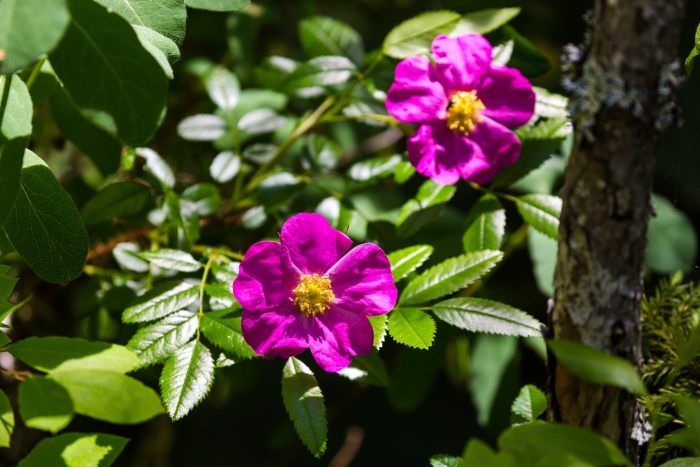Shining Rose
(Rosa nitida)
Shining Rose (Rosa nitida)
/
/

Melissa McMasters
CC BY 4.0
Image By:
Melissa McMasters
Recorded By:
Copyright:
CC BY 4.0
Copyright Notice:
Photo by: Melissa McMasters | License Type: CC BY 4.0 | License URL: http://creativecommons.org/licenses/by/4.0/ | Rights Holder: Melissa McMasters | Publisher: iNaturalist | Date Created: 2018-06-20T11:15:05-07:00 |















Estimated Native Range
Summary
Rosa nitida, commonly known as the Shining Rose, is a deciduous shrub native to the cool temperate regions of northeastern North America, particularly in wetland areas, bogs, and along pond edges. It typically grows up to 3 feet tall and wide, forming a low, suckering shrub with thin stems covered in fine bristles. The pinnate leaves are glossy green and notably turn bright red, yellow, and purple in the fall, providing seasonal interest. In summer, it produces small, fragrant pink flowers that are modestly showy, followed by small, red rose hips that persist into winter and provide food for wildlife.
The Shining Rose is valued for its hardiness and adaptability to a range of soil conditions, including wet soils, making it suitable for challenging garden spots. It is often used in naturalistic plantings, as a ground cover, and for erosion control on slopes near water bodies. This rose prefers full sun to partial shade and tolerates a variety of soil types, though it thrives in moist, well-drained soils. While generally low-maintenance, it can be susceptible to common rose diseases such as black spot and powdery mildew. Gardeners should be aware that it can spread aggressively by suckers, potentially becoming invasive in some conditions.CC BY-SA 4.0
The Shining Rose is valued for its hardiness and adaptability to a range of soil conditions, including wet soils, making it suitable for challenging garden spots. It is often used in naturalistic plantings, as a ground cover, and for erosion control on slopes near water bodies. This rose prefers full sun to partial shade and tolerates a variety of soil types, though it thrives in moist, well-drained soils. While generally low-maintenance, it can be susceptible to common rose diseases such as black spot and powdery mildew. Gardeners should be aware that it can spread aggressively by suckers, potentially becoming invasive in some conditions.CC BY-SA 4.0
Plant Description
- Plant Type: Shrub
- Height: 2-3 feet
- Width: 2-3 feet
- Growth Rate: Moderate
- Flower Color: Pink
- Flowering Season: Summer, Fall
- Leaf Retention: Deciduous
Growth Requirements
- Sun: Full Sun, Part Shade
- Water: Medium, High
- Drainage: Fast, Medium, Slow
Common Uses
Bird Garden, Border Plant, Butterfly Garden, Deer Resistant, Groundcover, Low Maintenance, Showy Flowers
Natural Habitat
Native to wetland areas, bogs, and along pond edges in northeastern North America
Other Names
Common Names: Shining Rose, Smooth Rose, New England Rose, Northeastern Rose
Scientific Names: , Rosa nitida, Rosa nitida f. spinosa, Rosa redoutea, Rosa redutea, Rosa redutea, Rosa redutea subsp. glauca, Rosa redutea subsp. rubescens, Rosa redutea subsp. rufescens, Rosa redutea var. glauca
GBIF Accepted Name: